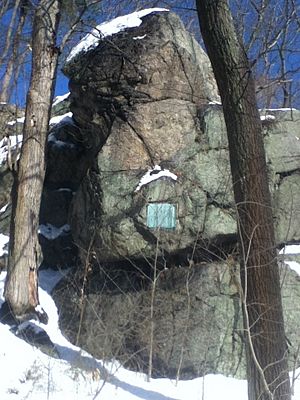Samuel Appleton (born 1625) facts for kids
Samuel Appleton (born 1625, died 1696) was an important leader in early America. He was a military commander and also worked in the government of the Massachusetts Bay Colony. During a big conflict called King Philip's War, he led soldiers in important battles like the Attack on Hatfield, Massachusetts and the Great Swamp Fight. Samuel Appleton also stood up against Governor Sir Edmund Andros.
Contents
Early Life in the Colonies
Samuel Appleton was born in 1625 in Little Waldingfield, England. When he was eleven years old, he moved to Ipswich, Massachusetts with his father.
Family Life
In 1651, Samuel Appleton married Hannah Paine. They had three children: Hannah, Judith, and Samuel. After Hannah passed away, he married Mary Oliver in 1656. With Mary, he had four more children: John, Isaac, Oliver, and Joanna.
Samuel Appleton later had a legal issue with the Saugus Iron Works. This was because his first wife's father, William Paine, had left money for Appleton's children from that marriage. Samuel Appleton Jr., his son, eventually gained control of the Ironmaster's House as part of the agreement.
Military Service
In 1668, Samuel Appleton became a deputy in the Massachusetts General Court, which was like a local government. He also became a Lieutenant in the military. He served alongside his brother, Captain John Appleton, for a few years. Later, he led his own company.
In 1675, a major conflict called King Philip's War began. Appleton was promoted to Captain. He was given command of 100 foot soldiers. He went to the Connecticut River Valley, where another company had been defeated.
On October 4, Major John Pynchon stepped down as the main commander in Hadley. Samuel Appleton was chosen to take his place. To protect the towns, Appleton split his army. One group went to Northampton, another to Hatfield, and Appleton led the third group in Hadley.
Battle at Hatfield
On October 19, 1675, fires were seen north of Hadley. A small group of scouts was attacked, and some were killed or captured. Reinforcements were called from Hadley and Northampton. Appleton and his men quickly joined the fight.
Around 4 PM, a large group of Native American warriors attacked Hatfield. Appleton defended one side of the town, while other captains defended other parts. During the intense fighting, a bullet went through Appleton's hat, but he was not hurt. After two hours, the warriors retreated. This battle was a big moment for the English colonists. It showed that they could defend themselves if they were ready.
Great Swamp Fight
In November 1675, leaders believed that the Narragansett tribe, who were supposed to be neutral, were helping Metacomet, the leader of the Native American forces. The colonies decided to attack the Narragansett.
On December 8, 527 soldiers from Massachusetts, led by Appleton, gathered in Dedham, Massachusetts. Other soldiers from Plymouth Colony and Connecticut, along with Mohegan warriors, joined them. Governor Josiah Winslow was the overall commander.
On December 19, 1675, they attacked the Narragansett fort in what became known as the Great Swamp Fight. It was a very tough battle. Many of Appleton's men were killed or wounded. After the fight, Appleton and his remaining soldiers returned to Boston, and he stopped his active military service.
Government Work
Samuel Appleton also served in government. From 1668 to 1686, he was a deputy to the Massachusetts General Court several times. He also became a member of the council of assistants, which was an important governing body.
Standing Up to Governor Andros
Samuel Appleton did not agree with the way Colonial Governor Sir Edmund Andros was running things. In 1687, Appleton refused to pay taxes that Andros had put in place without the council's approval. Because of this, a warrant was issued for Appleton's arrest. He was accused of being "disaffected to his Majesty's government."
It is said that Appleton hid at his son's home in Saugus. From a rocky cliff near the Iron Works, he reportedly gave a speech criticizing Governor Andros. This spot became known as Appleton's Pulpit.
Appleton was arrested on September 20 and stayed in prison until March 7, 1688. He was released after paying a large bond.
Later Years and Death
After the 1689 Boston revolt, Samuel Appleton was part of the council that governed Massachusetts until 1692. He also served as a judge. In 1692, he was part of the Governor's Council in Salem that questioned Elizabeth Proctor and Sarah Cloyce about accusations of witchcraft.
Samuel Appleton passed away on May 15, 1696.
Notable Descendants
Samuel Appleton has many famous descendants. These include President Calvin Coolidge, First Lady Jane Pierce, and Frances Appleton, who was the wife of the famous poet Henry Wadsworth Longfellow.


